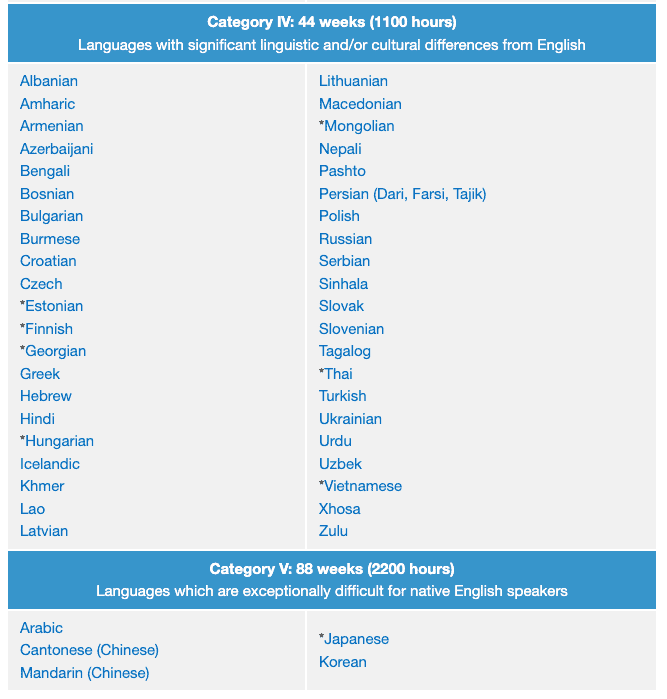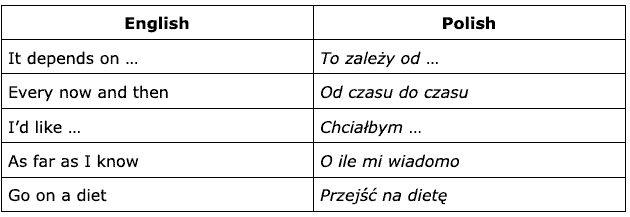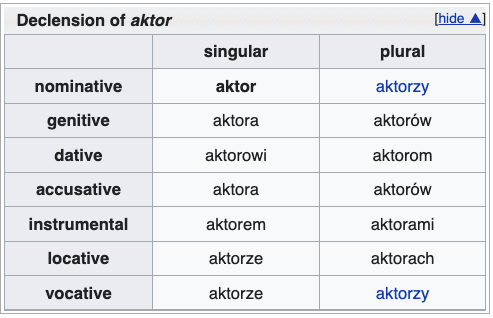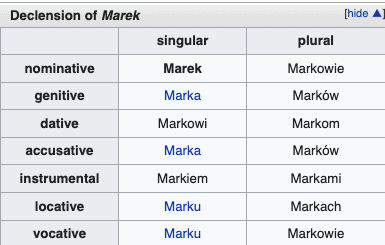“Is Polish difficult to learn?” I’ve been asked this question many times but I’m still not quite sure how to answer it. Those without a linguistic background are often overwhelmed by all the hype and stereotypes regarding what the hardest languages to learn are.
I’ve just discovered this list of the top 15 hardest languages to learn, for English speakers. It’s “based on insights from the Foreign Service Institute (FSI)”. The FSI ranked the languages based on how long it takes to master them right up to professional proficiency. I find such lists rather laughable. The Serbian language made the top fifteen languages in this list because it’s a “highly gendered language”. I was able to communicate in this language after only half a year of contact with it. It’s all about immersion, passion and dedication.
Polish – A category IV nightmare according to the Foreign Service Institute
Hence, we come to the Polish language. There’s no mention of Polish in the aforementioned list of the hardest languages to learn. However, Polish made it onto plenty of other lists of the most difficult languages to learn, such as this one, which the author has linked to the FSI.
The FSI takes the view that Polish is a category IV language. In other words, Polish is a language with “significant linguistic and/or cultural differences from English”. Apparently, learners of Polish require 1100 hours to reach General Professional Proficiency in speaking and reading:

Generally, I’m of the belief that grammar rules are eventually internalised through deep immersion in a language. Being surrounded by a language – be it via the media or at home – helps. Nevertheless, there are aspects of the Polish language which require some considerable attention. For instance, the seven cases are well-known for being the scourge of learners of Polish who can’t break out of intermediate-level mediocrity. For your information, cases refer to how nouns, adjectives and pronouns change their ending depending on their role in a sentence. More on Polish cases later.
Quick off the blocks – Mastering the basics of Polish
Let me explain how I picked up enough Polish to communicate throughout some of the earliest contact I had with the language. I’ll try to relate my experiences to what I believe are the most convincing arguments around in the field of second language acquisition (SLA).
Chunks, chunks and more chunks
In 2020, I wrote a review of The Lexical Approach: The State of ELT and a Way Forward – a book which undoubtedly had a huge influence on my thinking as an English language teacher.
Essentially, the author, Michael Lewis, argued that ‘language consists of chunks which, when combined, produce continuous coherent text’ (Lewis, 1997: 7).
These chunks may be in the form of, for instance:
- idioms
- collocations – natural combinations of words that are closely connected each other, e.g. make an effort
- sentence starters – for that reason, this means that
- verb patterns – e.g. verb + to-infinitive – I want to go, I need to have
When you begin to respect that your speech – in whatever language it is – is composed of these chunks, you’ll be able to banish any of those “Is Polish difficult to learn?” worries you might have.
Here are some chunks of language in Polish, together with translations in English, which you might hear and use on a regular basis:

Memorisation and repeated exposure are key when it comes to enabling these chunks to become part of your interlanguage (i.e. the idiolect or linguistic system second language learners use). There’s no need to analyse these chunks for their grammatical attributes and cases etc.
My trusty “Polish in 4 weeks” book
The previous section on chunks has its place in this post because learning Polish in chunks was partially my approach when I bought my first course book for learning Polish in 2006. This book is called Polish in 4 weeks.
The authors claim that the advantages of the book include “the natural contemporary language of the dialogues”. Well, I can say that the language of the dialogues is far from natural. However, the dialogues do represent (some) typical situations from everyday life. Most importantly, there are some useful chunks of language embedded within these dialogues.
Repeated rereading of these dialogues at the start of my learning adventure helped a large number of chunks and many of the characters’ utterances to “stick”.
In dialogue 1 – Sklep “karta” (In a Stationery Shop) – the very first utterance has been lodged in my mind for 17 long years:
Alice: O! Bardzo ładny kalendarz! (Oh! What a pretty diary!)
Unless your sole purpose in life is to loiter around stationery shops hollering ‘what a pretty diary!’, it’s a pretty useless utterance. Nevertheless, such nonsensicalities at least encouraged me to begin to notice and deduce basic grammatical patterns, which I acquired quite quickly. In this instance, kalendarz is a masculine noun as it ends in a consonant. Therefore, the adjective before it – ładny (pretty) – takes the ending -y because it accompanies a singular masculine noun.
It’s worth pointing out that there are a few exceptions to the rules above concerning adjectival endings before masculine nouns. The hard -y ending becomes a soft -i when preceded by particular consonants (k or g, and in some cases also n or p):
- drogi samochód (“expensive car”)
Do you fancy some cake?
In dialogue 5 – W kawiarni (In the cafe) – Waldek asks his friend “Czy masz ochotę na ciasto?” (Do you fancy some cake?). Early on, it’s vital to not get overwhelmed by “funny” inflected endings – ochota (fancying) becomes ochotę in the accusative case. Conversely, I’m of the belief that it’s critical to build up a stock of chunks, sentence starters and question starters that are instantly retrievable in conversation. They become instantly retrievable through repeated exposure, rereading and personalisation.
Personalisation
When you come across new words and chunks, it’s vital to personalise them. This means you should create two or three sentences about your own life, people you know and situations you’re familiar with which contain these new words and chunks. The purpose of all of this is, with regular rereading and repetition, these personalised sentences will be on the tip of your tongue and swirling around your mind in future conversations. This is the essence of fluency in a second language – being able to retrieve a wide range of chunks and personalised sentences at the drop of a hat.
For example, let’s imagine I’ve just come across the Polish word zasada (‘rule’ in English). My immediate goal would be to bend this word towards my experience and interests:
* I’m very familiar with the rules of snooker = Dobrze znam zasady gry w snookera
Regarding this personalised sentence, I’m not only preparing myself to retrieve it in a future conversation. I’m also picking up extra pieces of grammatical information as I go along. For instance, the feminine plural noun form of zasada is zasady in the accusative case (femine plural noun forms are the same in both the nominative and accusative cases).
Anyway, I’ve written extensively about personalisation and the need to store vocabulary, chunks and personalised sentences in a Word-Phrase Table on English Coach Online.
Overall, a foreign language is only hard to learn if you don’t have a language learning strategy to combat the supposed difficulty.
Four features of the Polish language which learners often complain are their nemesis
Let’s have a look at four features of the Polish language which might be particularly troublesome for learners to get a handle on. I shall draw some comparisons between English and Polish to highlight how those whose mother tongue is English might initially struggle with certain grammatical features of Polish.
1. Noun genders in Polish
The Polish gender system is very different from the English one – since gender in Polish is grammatical, whereas it is biological in English. For instance, the Polish word stół [table] is masculine, książka [book] is feminine, and jajko [egg] is neutral.
It’s worth mentioning that every noun has a grammatical gender and it’s not complicated to determine which is which. You can do it based on the last letter of a word (with a few exceptions):
Masculine nouns
These normally end in a consonant. Polish has eight vowels – o, a, I, e, y, u, ę, ą – meaning all the remaining letters are consonants. Based on that, we can assume that the majority of nouns in Polish are masculine.
There are some exceptions – some professions and sympathisers of some ideologies, despite ending in -a, refer to men. For example, artysta (artist), poeta (poet), pianista (pianist), socjalista (socialist), komunista (communist).
Interestingly, the Polish word for man (mężczyzna) ends in -a.
Feminine nouns
These normally end in -a but there is a small group of words which end in a consonant or -i. For instance, (pani = lady / Mrs) gospodyni (landlady).
Neuter nouns
Neuter nouns end in – o, -e, -ię -ę and -um – no exceptions here.
We can distinguish two additional gender categories for plural forms – rodzaj męskoosobowy (masculine personal forms) and rodzaj niemęskoosobowy (non-masculine forms). These plural forms are very easy to spot:
- Masculine personal nouns – Masucline personal nouns refer only to people – when there is at least one man in a group. For example, rodzice (parents), chłopcy (boys); or when we’re describing a group in a more general sense, for example, studenci (students) and Polacy (Poles). The gender of the people who belong to these groups is irrelevant.
- Non-masculine personal nouns – These refer to females, animals and objects. For example, if there is a group of 100 female students, we would say te studentki. But if a man joined the group, the form would change to ci studenci.
Why is it important to know the grammatical gender of nouns in Polish?
The gender of a noun has an influence on other parts of speech – adjectives, pronouns and numbers. For instance:
Ten bigos jest smaczny – This bigos is tasty
Ta zupa jest smaczna – This soup is tasty
To piwo jest smaczne – This beer is tasty
Te inteligentne kobiety – Those intelligent women
Ci inteligentni mężczyźni – Those intelligent men
Here are some verb forms in the past tense:
On czytał – He read
Ona czytała – She read
Ono czytało – It (a child) read
2. Polish is an inflected language
Open up any Polish grammar guidebook and you’ll soon come across the terms inflection or inflected.
Polish is an inflected language. Essentially, this means that adjectives, nouns and pronouns change their endings to show their relationship to the remaining words in their sentence (i.e. their case). Therefore, unlike English, Polish does not have articles (a/an/the or some/any) to show the relationship between words in a sentence.
Each word has a number of inflectional forms: nouns and pronouns 14, verbs have 47 (excluding participles), adjectives 44, numerals up to 49, and adverbs 3. (Lubaszewski, 2000).
In his 2000 paper, A Grammar for the Polish Inflection Lexicon, Lubaszewski provides the following list of inflection forms, with associated descriptions, for the personal male noun aktor (actor):

Notice how these inflections are heavily governed by their grammatical case descriptions (in the left hand column). For instance, for the dative singular case form, the inflection stem is aktor, while the inflection ending is -em.
Experienced multilingual tutor, Dana Bielec, wrote in her book – Basic Polish: A Grammar and Workbook – that “Polish is difficult for those not familiar with inflected languages” (2015: ix). This is somewhat of a generalisation. The intermediate learner has to hone his / her visual memory skills to be able to apply inflected forms, such as in the example above for aktor, to other personal male nouns when in the heat of conversation. This model list has to be littered with colour, bold font, italics and so on, so that visual memory can kick in.
The seven cases of Polish nouns
Learners of Polish often complain that cases are their main nemesis.
There are seven Polish cases:
- Nominative (mianownik)
- Genitive (dopełniacz)
- Dative (celownik),
- Accusative (biernik),
- Instrumental (narzędnik),
- Locative (miejscownik),
- Vocative (wołacz).
For the purposes of this post, let’s concern ourselves with Polish cases of nouns, remembering that adjectives and pronouns also have their own forms in accordance with case rules. Nouns change their ending according to their function in a sentence. Let’s check out the declension of the Polish male forename, Marek:

As you can see, Marek, in its nominative form, remains the same because it’s the subject of a verb. For example:
Marek jest mądry = Marek is smart
Genitive and accusative case forms are often identical. In my humble opinion, it’s worth devoting more study time to these cases than, say, the vocative or locative cases.
The accusative case expresses the direct object. It answers the questions kogo? (who?) and co? (what?):
Maria kocha Marka = Maria loves Marek
As for the genitive, it answers the questions kogo? / czego? – whose? Kogo refers to people, while czego refers to inanimate objects:
Syn Marka od rana płacze = Marek’s son has been crying since this morning
Possessives work quite differently in English and Polish. In English, the Saxon Genitive substitutes the word ‘of’ to denote possession. This is when we add ‘s to a name. For example:
This is Mark’s motorbike
It’s quite unnatural to say “This is the motorbike of Mark.”
However, in the example above, Syn Marka rather translates as “The son of Mark”. That’s just the way the genitive case works in Polish.
I could write another 10,000 words about Polish cases. Plenty more to come in future posts on Finding Poland.
3. Forming negative sentences in Polish
As regards Polish negation, the structure of negative sentences in Polish is different to that of negative sentences in English.
When negating a verb, you have to place the negative particle nie in front of it. It’s not possible to separate a verb from nie.
For example:
Nie mam czasu = I don’t have time.
Nie lubię swojej pracy = I don’t like my job
Double negation in Polish
Words such as nothing, never, nowhere, and so forth tend to go at the start of a sentence. Nie goes before the verb. This creates the impression of a “double negation”:
Nikt tu nie mieszka = Nobody lives here
Nic nie mam = I don’t have anything
Triple negations are nothing out of the ordinary in Polish
The title says it all.
Triple negations are quite common in Polish:
Nikt nic nie wie = Nobody knows anything
4. Affirmative sentences in Polish have a flexible word order for the sake of emphasis
Word order in a Polish sentence follows the subject-verb-object (SVO) order much less than in English.
In Polish, word order in affirmative sentences is much more flexible. Such creativity and freedom is rather for the sake of emphasis. To achieve emphasis when speaking, associated words are often separated. For example, a pronoun might be split from a verb, or an adjective split from a noun.
Bielec (2015: 198-199) offers some excellent examples of the various ways in which words may be separated. Here are two cases in point:
1. Takie chcesz oglądać filmy? instead of Chcesz oglądać takie filmy? (You want to watch such films?)
Here, the first option literally translates as “Such you want to watch films?” Hence, there’s a great deal of flexibility when it comes to choosing the position of emphatic words (i.e. takie – such) in a sentence.
2. Marta dwóch ma synów instead of Marta ma dwóch synów (Marta has two sons.)
Here, the word “two” appears after the subject of the sentence for emphasis.
In sum, learners of Polish have a great deal of freedom when it comes to word order. Still, learners shouldn’t be duped into thinking that any old word order will do. Word order often has an impact on the overall message and emphasis a speaker wishes to convey.
Two reasons why Polish isn’t that tough to learn
In the previous section, we looked at three reasons why Polish might be tricky to master. Now, let’s briefly consider two features of Polish – word stress and phonemic orthography – which are rather more favourable to learners:
1. Word stress in Polish
The theory suggests that word stress in Polish is rather predictable.
In most words, the second last syllable is stressed.
For example, stress falls on the first syllable for the Polish word for bicycle – rower. However, when inflections are added, the stress shifts to the second last syllable:
na rowerze = on a bike
z rowerami = with bicycles
There are some exceptions to the “second last syllable” word stress rule. For instance, the third last syllable is stressed in past tense verbs in the we and you (plural) parts. This is due to the fact that the ending itself comprises two syllables:
byliśmy = we were (masculine plural form)
czytaliście = you read (masculine plural form)
The third last syllable of Greek and Latin words also tend to be stressed:
gramatyka = grammar
feminizm = feminism
2. Polish is a (mostly) phonetic language
In the main, Polish is pronounced exactly as it is written.
So when you see a scary looking word such as czterdzieści (forty), its pronunciation is at least predictable.
Occasionally, minor changes can occur with certain groups of Polish letters. For instance, ę is pronounced as [e] before l or ł. However, with other consonants, it’s pronounced as [ɛn], [ɛŋ] or [ɛm]. In szczęście, the ę sounds like [ɛn] instead of [e].
Is Polish difficult to learn?
Admittedly, I’ve had a bit of an on-off relationship with the Polish language since 2005. Indeed, I’ve had to relearn the language.
When I read texts in Polish, I often come across interesting “chunks” of language (phrases and collocations) which I believe might be useful to use in conversation. I take these chunks and create personalised sentences with them. Sentences about my life, people I know and situations I’m familiar with.
It’s the same with all those finicky grammar points and cases. You need to create personalised sentences and short texts about your life or familiar subjects to have a personal language stock that “swims in your brain” when you’re actually speaking Polish.
Is Polish difficult to learn?
It’s only difficult if you believe all the hype and stereotypes about what the most difficult languages to learn are. After all, there’s plenty of evidence to suggest that the English language is difficult for Poles to learn. Let’s just stick to getting our heads down and becoming comfortable with a language learning strategy to nail these “difficult” languages.

